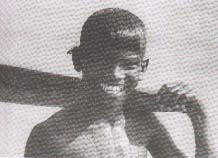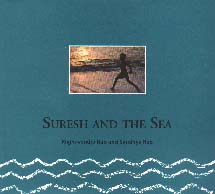|
________________
CM . . . .
Volume VII Number 6 . . . . November 17, 2000
excerpt: When they were little, Suresh and his friends spent all their time trying to learn to ride the tiny kattumaram his father had fashioned for them. It was everybody's favourite game.  Suresh and the Sea tells of the life of the people of Tamilnadu, a fishing village at the southern
tip of India. Sandhya Rao, an author of children's books, is also an editor with the publisher of this
story. Black and white photos, taken by Raghavendra Rao, show small Indian boys playing at the
seashore where they make small kattumarams, the fishing craft used by their ancestors and still
used today.
Suresh and the Sea tells of the life of the people of Tamilnadu, a fishing village at the southern
tip of India. Sandhya Rao, an author of children's books, is also an editor with the publisher of this
story. Black and white photos, taken by Raghavendra Rao, show small Indian boys playing at the
seashore where they make small kattumarams, the fishing craft used by their ancestors and still
used today.
One is immediately hopeful that no scarcity of fish exists in Tamilnadu, but, alas, the book reveals much the same problems existing there as exist in maritime Canada - draggers and trawlers greedily scoop up more than their share of fish; sewage and plastic contaminate the ocean; young people leave home to look elsewhere for work. Photographs are excellent and numerous, side issues are raised comparing conditions in Tamilnadu to Alaska, for instance, and notes for parents and teachers are included at the end of the book. Although the paper is of good quality, the binding does not feel quite sturdy enough, and it is doubtful how well it would stand up to use in a school library. The long, complicated names of the main characters, and the geographical place names take patience to absorb, but Suresh and the Sea will be of special interest to those with an Indian background. For a comparative study of methods of fishing in India and elsewhere, it will also be useful. Recommended. Joan Payzant is a former teacher-librarian, living in Dartmouth, NS.
To comment on this title or this review, send mail to cm@umanitoba.ca.
Copyright © the Manitoba Library Association.
Reproduction for personal use is permitted only if this copyright notice
is maintained. Any other reproduction is prohibited without
permission.
Published by
TABLE OF CONTENTS FOR THIS ISSUE - November 17, 2000.
AUTHORS |
TITLES |
MEDIA REVIEWS |
PROFILES |
BACK ISSUES |
SEARCH |
ORDER |
CMARCHIVE |
HOME
|
